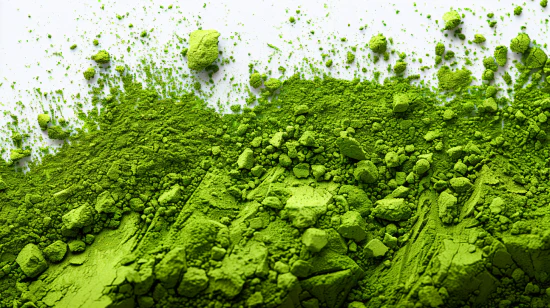Introduction: Why Matcha Quality Matters
Matcha’s popularity is soaring, and for good reason—it’s a powerhouse of antioxidants, energy, and calm. But here’s the catch: not all matcha is created equal. Whether you’re sipping it for stress relief, a metabolism boost, or just that vibrant green vibe, quality makes all the difference. So, how do you spot a high-quality matcha from a less impressive one? This guide breaks it down with simple, practical tips—no guesswork needed. Let’s dive in and ensure your next cup is the real deal.

1. Check the Color: Vibrant Green vs. Dull Tones
The first clue to matcha quality is right in front of you: its color. High-quality matcha boasts a bright, vibrant green hue—think fresh spring leaves. This comes from shade-growing, a process where tea plants are covered 20-30 days before harvest. It boosts chlorophyll and amino acids, giving that rich green glow.
Low-quality matcha? It’s often dull, yellowish, or even brownish. This happens when leaves are exposed to too much sun or harvested from older plants, stripping away nutrients and flavor. Next time you’re shopping, hold the powder up to the light—vibrant green is your green light.
2. Feel the Texture: Silky Smooth vs. Gritty
Run a pinch of matcha between your fingers. Top-tier matcha feels silky and fine, almost like baby powder. This is because it’s stone-ground from young, tender leaves (called tencha) into a superfine powder—about 5-10 microns. That smoothness ensures it whisks into a creamy, frothy cup without clumps.
Lower-quality matcha, often made from coarser leaves or machine-ground, feels gritty or sandy. It might clump when you mix it, leaving a rough mouthfeel. If it’s not silky to the touch, it’s likely not the best pick for your daily ritual.
3. Taste the Difference: Umami vs. Bitter
Flavor is where high-quality matcha shines. Ceremonial-grade matcha—made from the youngest, most nutrient-rich leaves—offers a smooth, umami taste with a hint of natural sweetness. It’s earthy but balanced, with no harsh aftertaste. This comes from high L-theanine levels, which mellow out bitterness and boost that calming effect.
Low-quality matcha, often culinary-grade or worse, leans bitter, astringent, or even grassy. It’s typically harvested later, from tougher leaves with less L-theanine and more tannins. Sip before you commit—a good matcha should feel like a treat, not a chore.
4. Smell the Aroma: Fresh vs. Stale
Give your matcha a sniff before brewing. High-quality matcha smells fresh, grassy, and slightly sweet—like a walk through a tea field. This aroma comes from careful harvesting and storage, preserving the leaves’ natural essence.
Poor-quality matcha might smell stale, musty, or even burnt. That’s a sign of old leaves, improper processing, or exposure to air and light. A dull scent often means dull benefits, so trust your nose—it’s a quick quality check.
5. Look at Origin: Japan vs. Elsewhere
Matcha’s roots are in Japan, where centuries of tradition perfect its craft. High-quality matcha often hails from regions like Uji, Nishio, or Shizuoka, known for ideal soil and climate. Japanese matcha is shade-grown, hand-picked, and stone-ground—standards that ensure top flavor and nutrition.
Lower-quality matcha might come from other countries with less rigorous methods. It’s often mass-produced, sun-grown, or blended with fillers. Check the label—Japan’s heritage is a strong clue to quality.
6. Price Point: Investment vs. Bargain
Quality matcha isn’t cheap, and that’s okay. Ceremonial-grade matcha (30g) typically costs $30-$50, reflecting the labor-intensive process—shade-growing, hand-harvesting, and stone-grinding. You’re paying for potency: more antioxidants, L-theanine, and flavor in every sip.
Bargain matcha under $10? It’s likely culinary-grade or lower, made for baking, not drinking. It skimps on nutrients and taste. If it’s too good to be true, it probably is—invest in matcha that delivers.
How to Choose Your Matcha
Start with these checks: vibrant green, silky texture, umami flavor, fresh aroma, Japanese origin, and a fair price. Read labels—look for “ceremonial grade” or “organic” for extra assurance. Taste-test small batches if you can. Once you find a winner, whisk it into hot water (175°F) for the best experience—smooth, frothy, and full of goodness.
Conclusion: Your Perfect Matcha Awaits
Spotting high-quality matcha isn’t hard once you know what to look for. It’s about color, feel, taste, smell, origin, and value—simple cues for a standout cup. Why settle for less when you can sip the best? Have you found your matcha match yet?
Ready to sip the good stuff? Try our Matcha Essentials Starter Kit—ceremonial-grade organic matcha (2.1 oz / 60g), a refillable Tenzo tin, an electric mixer, and a scooper. It’s silky smooth, full of flavor, and undeniably delicious. Get 20% off and start your matcha journey right!


